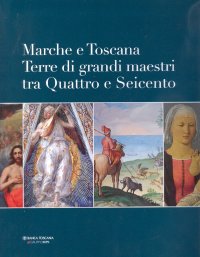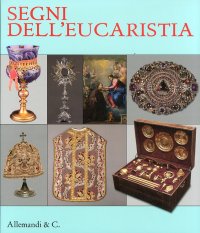Beato Angelico
Firenze, Palazzo Strozzi, September 26, 2025 - January 25, 2026.
Edited by Carl Brandon Strehlke.
Testi di Stefano Casciu, Marco Mozzo, Angelo Tartuferi.
Venezia, 2025; bound, pp. 456, 300 col. ill., cm 24x29.
cover price: € 80.00
|
Books included in the offer:
Beato Angelico
Firenze, Palazzo Strozzi, September 26, 2025 - January 25, 2026.
Edited by Carl Brandon Strehlke.
Testi di Stefano Casciu, Marco Mozzo, Angelo Tartuferi.
Venezia, 2025; bound, pp. 456, 300 col. ill., cm 24x29.
FREE (cover price: € 80.00)
Marche e Toscana. Terre di grandi maestri tra Quattro e Seicento
Ospedaletto, 2007; bound, pp. 320, col. ill., col. plates, cm 25,5x29.
FREE (cover price: € 77.00)
Segni dell'Eucarestia
Edited by M. Luisa Polichetti.
Ancona, Osimo, Loreto Jesi, Senigallia, Fabriano e Metelica, 23 giugno - 31 ottobre 2011.
Torino, 2011; paperback, pp. 221, b/w and col. ill., cm 24x28.
FREE (cover price: € 32.00)
The Museum of Rome tells the story of the city. Concise guide
Gangemi Editore
English Text.
Roma, 2003; paperback, pp. 192, ill., cm 15x21.
(Arte, Arredamento, Disegno).
series: Arte, Arredamento, Disegno
ISBN: 88-492-0395-0 - EAN13: 9788849203950
Subject: Essays (Art or Architecture),Historical Essays,Towns,Travel's Culture
Period: 1400-1800 (XV-XVIII) Renaissance
Places: Italy,Rome
Languages: 
Weight: 0.469 kg
On the other hand, all the difficulties and ambiguities which would characterise its journey were already implicit in the ambitious task of wanting to set up a Museum which was able to reconstruct in an exhaustive manner, into a single large fresco, the secular history of Rome, from the city of the popes to the young capital of Italy.
In fact, at the time of the inauguration of the Museum of Rome in 1930, Antonio Muñoz, the then Director of Antiquities and Fine Arts of the Governorship of Rome, whilst proudly claiming responsibility for the much awaited implementation and layout of the Museum, felt the need to justify its institution in a city like Rome so richly endowed with Museums which were "already so great and famous and celebrated throughout the world; to which flock pilgrims of the ideal and people from every country; where those masterpieces are housed which all nations envy us".
In harmony with the cultural climate of his time, in which the remembrance of the profound transformation experienced by the city in becoming the capital of Italy was still fresh, he identified the conservation of the memory of the city's life, traditions and image as the justification for the existence of the Museum of Rome. It was intended to be, according to Muñoz, "the urn of sweet nostalgias, the refuge of our dreamy soul, the oasis where we Romans will be able to recreate our spirit, among the beloved small things of the life that once was!"
In effect, this first stage in the Museum's life was entirely addressed at elegising and, at the same time, documenting, in a desire to fix and hand down to the collective imagination of posterity the beauty and the poetry of the Rome which had vanished or which was vanishing in the town-planning and building fervour of the Fascist period.
The outbreak of the Second World War forced the closure of the Museum, which at that time was located in the great building on Via dei Cerchi whose façade bore the proud inscription "Palace of the Museums of Rome". When the Museum was reorganised, after the war, the need was felt to find premises which, in terms both of historical and architectural prestige and of location, would fully correspond with the quality and the importance of the collections and would allow for their more extensive and complete development. Not without a "tough fight", as Antonio Maria Colini recalls, the Museum of Rome obtained the eighteenth-century Palazzo Braschi, thus being able to reopen to the public in 1952 based on a layout in three large sections, topography, history and customs, which, broadly speaking, complied with the configuration of the 1930s.
This was a very successful period for the Museum due the public's goodwill and to the constant and valuable increase of its collections, thanks in part to the generous activity of the "Associazione degli Amici dei Musei" which encouraged important bequests and donations.
In fact, by the early 1960s it had already become necessary to proceed with a modification of the exhibition set-up, both due to the need to include the new acquisitions in the original itinerary and due to an alteration in museological sensitivity; the desire to provide documentation was refined with the intention of giving preference at exhibition level to the aesthetic quality of the materials, which were also arranged according to more precise chronological criteria.
However, the arrangement arrived at was "an arrangement of convenience, suited to the rooms and to the available material rather than being systematic and rational", as Carlo Pietrangeli noted.
In the subsequent decades, the enrichment of the collections with works of considerable historical-artistic value and the significant importance of the creation of the Communal Prints Studio and the Communal Photographic Archive were not expressed, however, in a contextual reflection on the need to critically re-examine and update the inspiring criteria of the Museum in the light of the new cultural expectations dictated by the profound changes in methodology and the social context. Those same years also saw the start of the slow but inexorable structural decline of Palazzo Braschi, which in 1987 led to its closure.
Having finally succeeded, after fifteen years, in partially re-opening the Palace, it was necessary to decide exactly what to offer to the public of the Museum's rich collections, what selection of its vast and subdivided heritage and which interpretation should be given preference to: whether to propose a presentation of works which would represent the definitive, albeit limited, layout of the museum of Rome or whether to present a chronological anthology, from the Middle Ages to the twentieth century, of the artistically and historically more important and significant exhibits.
Neither of these solutions seemed convincing, the former because, precisely because of its partiality, it would have been fragmentary and incomplete and therefore difficult for the public to understand, the latter because to a certain extent it would have negated the extraordinary capacity of the Museum to recount and evoke the many possible "histories" of Rome.
The Museum of Rome, on account of the richness of its collections, also characterised by a remarkable variety of artistic techniques, can in fact be considered as the most significant institution for our knowledge of social history and artistic activities in Rome from the Middle Ages to the beginning of last century.
The narrative dimension, complying with the first and fundamental documentary vocation of the Museum, is the hinge around which its numerous and variegated collections can revolve; by combining their intrinsic value with the narration's potential for suggestion, their significances are multiplied and a fascinating interplay of routes is made possible through the myriad incidents, situations, events, vicissitudes and personalities forming the historical and social secular fabric of the city.
The current proposal consists of an interpretation supplemented with extracts of several chapters in the city's history; this, although not intentionally wishing to herald the definitive configuration of the Museum, emblematically foreshadows its future potential and the role which, once the works of the second lot are concluded, it will be able to play in the Roman museum system.
From the very extensive range of narrative plots which Rome and the Museum might suggest, a themed scenario has been chosen which, through protagonists, events and place, availing itself of the multitude of artistic techniques, might offer the visitor a sequence of suggestions about life and society in Rome between the seventeenth and nineteenth century according to an itinerary which is not strictly chronological but plays rather on cross-references and assonances.
The precious spectacular backdrop and the noble prologue of the exhibition is Palazzo Braschi itself, commissioned by Pope Pius VI as a residence for his nephew Luigi and for his wife Costanza Falconieri.
The recent restorations have restored splendour to the noble architecture designed by Cosimo Morelli at the end of the eighteenth century, to the majestic elegance of the atrium and the staircase, to the refinement of the stuccoes, of the paintings and the decorative parts. In particular, the decoration of the staircase, of daring spatial articulation to which baroque reminiscences are not unrelated, is a testimony of great significance to the classicist taste tinged with the antiquarian erudition of the epoch. In the use of the very beautiful red granite columns from the Portico of Caligula, crowned with elegant Ionic capitals adorned with the heraldic motifs of the Braschi coat of arms, the red granite pillars originating from the Antonine column, in the niches adorned with statues - the last surviving examples of the famous collection of the family's classical sculptures - and, finally, in the exuberant profusion of stuccoes which cover ceilings and walls inspired by the myth of Achilles, the work of Luigi Acquisti, it is the Ancient which triumphs, the sign and measure of pomp and power.
Metaphorically closing the prologue, the entrance hall on the first floor displays canvases by Gavin Hamilton depicting Venus offering Helen to Paris, The Rape of Helen and The Death of Achilles, once in the Villa Borghese. These paintings, of great decorative effect, coeval with the Oath of the Horatii by David, are among the works which, precisely during the pontificate of Pius VI, inaugurated the great Roman neoclassical period.
The due homage to Pius VI, who was responsible for the palace, is made more complete by the restoration to their original setting of the two busts of the pope and of the cardinal Romualdo Braschi Onesti, respectively the work of Ceracchi and Penna, recently acquired from the family and exhibited to the public for the first time.
The narration shifts backwards in order to present the papal court in terms of its protagonists and events, between the seventeenth and nineteenth century, in a sequence of images of popes and cardinals, of celebrative and allegorical pictures, drawings and engravings which reconstruct the sumptuous, colourful and vibrant portrait of the papal city.
The Campidoglio, seat of the city's administration, where, even if only with symbolic powers, resided the Roman magistracies of the Senator and the Conservators, is recalled by the Portrait of Senator Nicola Bielke and by the costumes of the Senator and his page.
Over the centuries, Rome has offered artists an inexhaustible subject, with its piazzas, its famous ancient monuments, its circle of villas and its panoramic views; the view of various places - interweaving everyday life and historical events - has often acquired the twofold value of identifying both the city and its urban scenarios. For this reason we have placed side by side, for example - deliberately playing on a double register - The Arrival at the Quirinal of the Veneto Ambassador Nicola Duodo and the Arch of Titus by Viviano Codazzi, and the Papal Blessing in Saint Peter's Square by Ippolito Caffi and the extraordinary view of Rome from Monte Mario, also by Caffi.
The story of the city concludes with the recollection of that particular cultural climate which between the eighteenth and nineteenth century made Rome the cosmopolitan capital of artists and educated travellers, in which the evocation of classical antiquity nurtured an extraordinary microcosm of the ancient. To complete the outline of Roman society, a small collection of clothes of the period introduces the fashion codes of the ruling class.
The second floor is dedicated to the patronage of several great Roman families of which the Museum of Rome preserves important examples; in an excursus which goes from the seventeenth to the nineteenth century, by means of the variety of artistic techniques and themes, the succession of the various commissioners unravels, marked by changes in taste and the logics of social representation.
The Barberini are represented, not only by the busts by Mochi, by Ottoni and Cametti and other works, but also by the expressly restored Baldachin Ceiling decorated with the heraldic bees of the house woven to a design by Pietro da Cortona in the family tapestry factory and by the Medal Showcase dating back to the first half of the seventeenth century with the celebrative medals of the pontificate of Urban VIII organically exhibited for the first time.
With the Rospigliosi collection, one of the Museum's first important acquisitions (1931-1932), it is possible to re-evoke the rhythms of life, marked by festivals and anniversaries in the Esquilino residence and on the Maccarese estate, of a noble family in the course of the eighteenth century.
The model for the Rospigliosi Chapel in San Francesco a Ripa by Nicola Michetti documents, on the other hand, the traditional custom of Roman families to commission their own aristocratic chapel in the city's churches.
In the course of the nineteenth century Roman patronage experienced its last splendid period with the Torlonia commissions. In particular, the Museum houses some extraordinary tokens linked to the decoration of the destroyed Palazzo Torlonia in Piazza Venezia, of the Apollo Theatre demolished in 1889 to make way for the construction of the Tiber embankments and of the Villa di Castel Gandolfo. The refined elegance of the stuccoes and paintings, in the so-called "Alcove", emblematically closes the re-evocation of the magnificence of the Torlonia residences and of their role in Roman artistic culture.
The Giustiniani Bandini and Brancaccio collections aim to bring into focus Roman aristocratic society through a sequence of portraits which, from the exquisite smoothness of the bust of Maria Massani by Thorvaldsen, passes on to the sumptuous and charming manner of Gai, an efficacious example of the eclectic taste of the young capital of Italy.
The last room of the exhibition is dedicated to the transition from papal Rome to Rome the capital of the Kingdom of Italy, with a targeted selection of the rich and complex fund of the Communal Photographic Archive. As compared to the more usual views of the city, it has been preferred to select several significant portrait examples as a logical continuation of the portraiture of the century, which in the recent photographic technique had found new results and a wider clientele.
The works presented constitute only a small cross-section of that mine of figurative sources housed in the Museum, a priceless heritage for those who wish to study or simply become acquainted with the artistic and social secular history of Rome.











